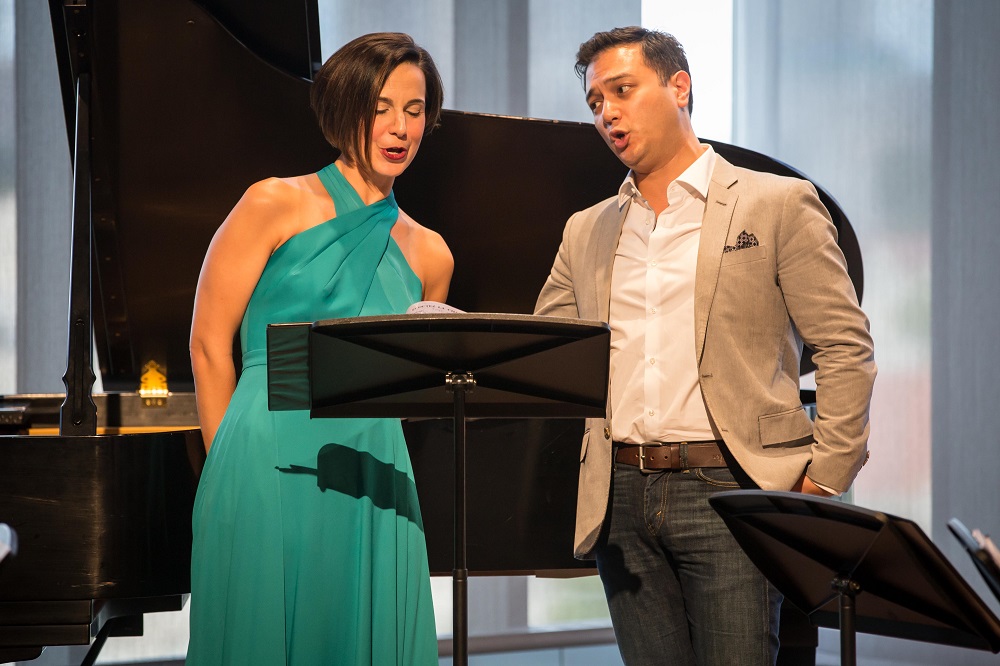French song proves tres bon at Collaborative Works Festival finale

On Saturday afternoon, we bid adieu to the Collaborative Arts Institute of Chicago’s fifth Collaborative Works Festival at its closing concert, the second of two celebrating the poetry of Paul Verlaine and his fellow Symbolists. Singers Kelley O’Connor and Nicholas Phan (also the artistic director) were accompanied by pianist Scott Allen Jarrett and the Spektral Quartet at the Reva and David Logan Center for the Arts at the University of Chicago.
The concert featured two mainstays of the French art song repertoire—Fauré’s La bonne chanson and Debussy’s Chansons de Bilitis—with two comparative rarities as bookends.
The first rarity was Chanson perpétuelle, a delectable setting of Charles Cros’s poem by composer Ernest Chausson, in what was his last completed work before the bicycle accident that took his life. The second rarity was a bit of crossover: selections from singer-songwriter Léo Ferré’s 1964 album Verlaine et Rimbaud, with the accompaniments re-arranged for piano and string quartet by Doug Peck.
O’Connor sang both the Chausson and the Debussy. Throughout, she seemed to struggle a bit with the words. Some were smudged into indiscernibility. And sometimes she inadvertently substituted other words entirely, thus garbling the meaning of certain sentences. For example, a “je” substituted for a “tu” radically altered the protagonist’s declaration to her lover at the heart of Chanson perpétuelle.
But in spite of this, she displayed a keen intelligence for the narrative arcs of the characters she portrayed. In the Chausson, her entire bearing changed perceptibly as her character moved from plaintive present into pleasurable past. And in one brief span in the middle of Debussy’s “La chevelure,” she projected the protagonist’s meditative lull after an embrace and then her mounting excitement as she experiences an existential fusion with her lover.
Phan was the soloist for the Fauré. Whereas O’Connor shaped her songs in broad expanses of emotion, Phan tended to pack meaning into individual words. There was a manic gleam in his voice as he announced daybreak in the second song. And his serene final note on the word “exquise” (“exquisite”) closing the third song was like the word itself.
Jarrett’s accompaniments revealed great sensitivity to the fact that Fauré and Debussy are quite different animals.
In “La lune blanche luit dans les bois” from La bonne chanson, there’s a particularly evocative set of chord changes depicting reflections of the landscape in the waters of the pond. Jarrett conveyed all of the subtle mood changes in this passage with astonishing clarity.
But that clarity was replaced with a suitable smokiness in the Debussy. No sharp edges here. Even the croaking of frogs in the first movement was murmured through mist.
The Ferré set marked a large stylistic change for all involved. Phan was as mellifluent as always, but not terribly idiomatic. This kind of music is typically delivered midway between speech and song, weaving flexibly in and out of time. But Phan played the rhythms fairly straight and sang full-on throughout.
O’Connor adapted better to the speechlike qualities of the style. Her patter in “Mes petites amoureuses” bounced playfully. And she dug her voice with relish into the grislier adjectives of “Les chercheuses de poux,” while still lending the waltz rhythms their requisite lilt.
In their accompaniments, the Spektral Quartet were deft stylistic chameleons. There’s a special sound that Chausson and Fauré require: as if the strings were clad in satin. The quartet produced this sound with such alacrity that you could isolate any phrase they played and know that it was French. They were equally on point in the Ferré: schmaltzy or jaunty as needed. You would think they had been backing chanteuses for years.
Posted in Uncategorized




